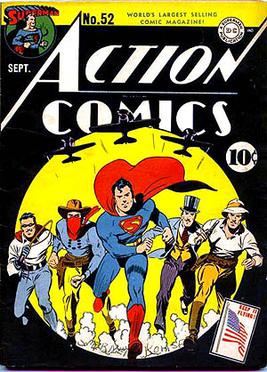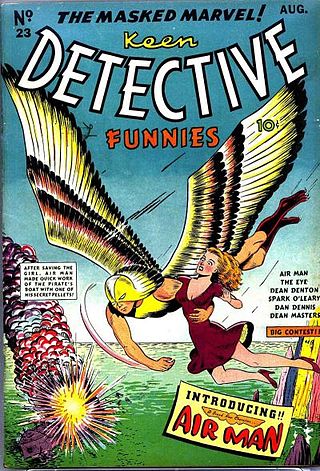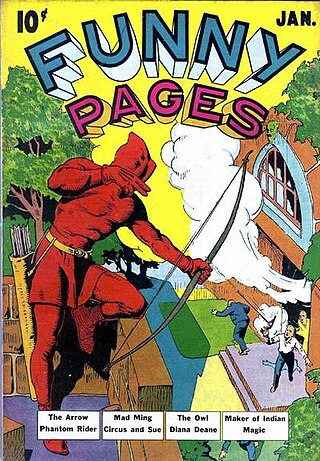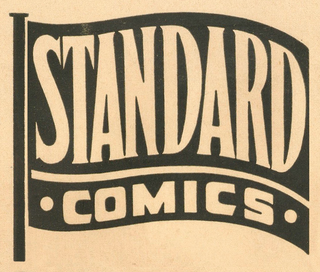
Starman is a fictional superhero appearing in media published by DC Comics, primarily as a member of the Justice Society of America. Created by writer Gardner Fox and artist Jack Burnley, he first appeared in Adventure Comics #61.
"Alias the Spider" is a superhero feature from the Golden Age of Comic Books that appeared in Quality Comics' Crack Comics for nearly three years, starting with issue #1 in 1940. He was created by writer-artist Paul Gustavson.

Madam Fatal is a fictional character and a comic book superhero active during the Golden Age of Comic Books. Madam Fatal was created and originally illustrated by artist/writer Art Pinajian and the debut of the character was in the Crack Comics #1, a crime/detective anthology series published by Quality Comics. Madam Fatal continued as a feature in that title but when the character was not well received, Madam Fatal made a last appearance in #22.
Centaur Publications was one of the earliest American comic book publishers. During their short existence, they created several colorful characters, including Bill Everett's Amazing-Man.

The Blonde Phantom is a fictional masked crime fighter appearing in American comic books published by Marvel Comics. Created for Marvel predecessor Timely Comics by Stan Lee and Syd Shores, the character first appeared in All Select Comics #11, during the 1940s period fans and historians call the Golden Age of Comic Books. The heroine was so well received that the next issue was retitled The Blonde Phantom. The series continued to feature her until issue #22. She also appeared in backup stories in many other Timely comics; in Superhero Comics of the Golden Age, Mike Benton observes that "for a few months in 1948, readers could find her in seven titles on the newsstand." In The Supergirls, Mike Madrid asserted, "Once again, a capable woman hid behind a meek persona and only let her hair down, literally, to come to the aid of a man who completely ignored her unless she assumed a disguise. In a 1947 story entitled "I Hate Myself", Louise even dreams that Mark finally confesses his love for her, only to have the Blonde Phantom persona appear and steal him away."

Captain Triumph is a superhero from the Golden Age of Comics who first appeared in Crack Comics #27, published in January 1943 by Quality Comics. He continued to appear until the end of the series with issue #62.

Harry "Tex" Thompson is a superhero owned by DC Comics who later became the masked crime-fighter Mr. America and then became an espionage operative called Americommando. He was often aided by his best friend Bob Daley, who for a brief time operated as his costumed sidekick "Fatman". Created by Ken Fitch and Bernard Baily, Tex debuted in Action Comics #1, the same comic that introduced Superman. During his original stories of the 1940s, several of his enemies were based on Yellow Peril stereotypes. Several of his earliest stories featured Gargantua T. Potts, a character based around minstrel show stereotypes about African-Americans.

Midnight is a fictional character owned by DC Comics. A masked detective, he was created by writer-artist Jack Cole for Quality Comics during the 1930s to 1940s period known as the Golden Age of Comic Books.

Airman is a fictional, comic-book superhero first published by Centaur Publications in 1940, during the period fans and historians call the Golden Age of Comic Books. He first appeared in Keen Detective Funnies #23, in a story by artist Harry Sahle and an unconfirmed writer, generally credited as George Kapitan. Keen Detective Funnies was cancelled after issue #24, but Centaur published two more stories in Detective Eye Comics #1 and 2 before pulling the plug on the character.

The Arrow is a fictional superhero created during the Golden Age of Comic Books. He was the first superhero published by Centaur Publications.

Jester is a fictional character, a Golden Age superhero created by Paul Gustavson and published by Quality Comics. He first appeared in Smash Comics #22. Like most of Quality's characters, the Jester was later purchased by DC Comics and incorporated into their universe. Though little used by the company, he appeared in All-Star Squadron #31 and #60 and Starman #46. The character's last Golden Age appearance was in Smash Comics #85.

Wildfire is a fictional superhero in the DC Comics universe. One of the first female superheroes, she was originally published by Quality Comics during what comics historians and fans called the Golden Age of comic books. With her luxurious mane of red hair and revealing costume, she has been called "the sexiest super-hero of 1941".
The Fantom of the Fair is one of the earliest published Golden Age superheroes. He debuted in Centaur Publications' Amazing Mystery Funnies vol. 2, #7, the overall 11th issue of that title. He premiered, according to cover dates, the same month as DC Comics' Sandman, Fox Publications' The Flame, and Centaur's Masked Marvel. He was created by Paul Gustavson, who had previously created the Arrow for Centaur.
The Green Mask is the name of two comic book superheroes, both published by Fox Feature Syndicate. Both are in the public domain with some of the original stories having been reprinted by AC Comics.
The Masked Raider is an alias of several fictional characters appearing in American comic books published by Marvel Comics. The original character went by the name of Jim Gardley and appeared in comic books published during the 1930s and 1940s period known as the Golden Age of Comic Books, he was created by writer and artist Al Anders. Jim Gardley was a gunslinger and former rancher active during the American frontier. He was one of the few individuals that held the Eternity Mask for a short period, and succeeded by Dirk Mehler. In Marvel Comics #1000, it was revealed how the Golden Age Masked Raider died and a new character, initially unnamed but later unidentified as Carlo Zota, had taken up the name, also in possession of the Eternity Mask.

The Masked Marvel is a fictional superhero originally published by Centaur Publications. He debuted in July 1939, on the pages of Keen Detective Funnies #7. The character continued to appear as the feature in Keen Detective Funnies until the 24th issue, as well as in his own title, which lasted three issues.

Standard Comics was a comic book imprint of American publisher Ned Pines, who also published pulp magazines and paperback books. Standard in turn was the parent company of two comic-book lines: Better Publications and Nedor Publishing. Collectors and historians sometimes refer to them collectively as "Standard/Better/Nedor".

The Face is a fictional character, a comic book superhero that appeared in 1940s comics during what historians and fans call the Golden Age of Comic Books. He was created by artist Mart Bailey and an unknown writer.

The Eye is a fictional comic book character created by Frank Thomas and published by Centaur Publications. The character had no origin story, and existed only as a giant, floating, disembodied eye, wreathed in a halo of golden light. This powerful being was obsessed with the concept of justice, and existed to encourage average people to do what they could to attain it for themselves. If the obstacles proved too great, the Eye would assist its mortal charges by working miracles. Time and space meant nothing to the Eye and it existed as a physical embodiment of man's inner conscience.















